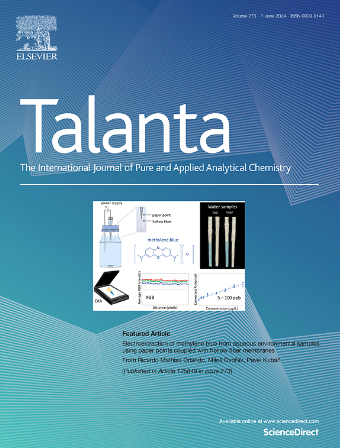Dried blood spot microsampling: A semi-quantitative 4D-lipidomics approach using ultrahigh-performance liquid chromatography - high-resolution mass spectrometry (UHPLC - HRMS)
IF 5.6
1区 化学
Q1 CHEMISTRY, ANALYTICAL
引用次数: 0
Abstract
Dried blood spot (DBS) sample collections can offer a minimally invasive, cost-effective alternative to traditional venepuncture for remote sampling and high-frequency metabolic profiling. We present an optimized protocol for DBS-based extraction and comprehensive untargeted 4D lipid profiling using ultrahigh-performance liquid chromatography coupled with high-resolution mass spectrometry (trapped ion mobility - mass spectrometry), designed to support large-scale applications in population-wide lipidomics research. Inclusion of stable isotopically labelled internal standards allowed for semi-quantitative subclass-level correction for 10 μL DBS samples, enhancing the number of reproducible lipids within our curated target list (focussed on 432 unique rule-based lipid annotations out of 6845 features) across positive and negative heated electrospray ionization modes. The reproducibility of unique lipid features detected in replicate DBS (n = 6) was assessed on both peak areas (351 lipids <25 % CV) and calculated concentrations relative to internal standards (432 lipids <25 % CV), underscoring the benefit of internal standard addition. Storage conditions for DBS were also evaluated to determine short-term lipid stability at different temperatures (−20 °C, 4 °C, room temperature, and 45 °C). The majority of lipid subclasses, excluding a minority of glycerophospholipids and oxylipins, were stable up to 1 week at −20 °C and 4 °C (log2-fold change <30 % difference), which supports the short-term storage capacity for DBS in field and clinical settings. Similar stability was observed within a week at room temperature, excluding phosphatidylethanolamines and phosphatidylglycerols (log2-fold change >30 % difference). Application of the optimized workflow to a microsampling device (n = 6) identified 432 unique lipid features (CV < 25 %) with three repeated samplings over an hour showing minimal impact on lipid profiles by principal component analysis, showing promise for high-frequency, longitudinal DBS monitoring in population health. This work represents a significant advance, highlighting the potential for reliable lipid analysis from DBS samples with short-term stability under various storage conditions, an important logistical benefit for remote or resource-limited settings.

求助全文
约1分钟内获得全文
求助全文
来源期刊

Talanta
化学-分析化学
CiteScore
12.30
自引率
4.90%
发文量
861
审稿时长
29 days
期刊介绍:
Talanta provides a forum for the publication of original research papers, short communications, and critical reviews in all branches of pure and applied analytical chemistry. Papers are evaluated based on established guidelines, including the fundamental nature of the study, scientific novelty, substantial improvement or advantage over existing technology or methods, and demonstrated analytical applicability. Original research papers on fundamental studies, and on novel sensor and instrumentation developments, are encouraged. Novel or improved applications in areas such as clinical and biological chemistry, environmental analysis, geochemistry, materials science and engineering, and analytical platforms for omics development are welcome.
Analytical performance of methods should be determined, including interference and matrix effects, and methods should be validated by comparison with a standard method, or analysis of a certified reference material. Simple spiking recoveries may not be sufficient. The developed method should especially comprise information on selectivity, sensitivity, detection limits, accuracy, and reliability. However, applying official validation or robustness studies to a routine method or technique does not necessarily constitute novelty. Proper statistical treatment of the data should be provided. Relevant literature should be cited, including related publications by the authors, and authors should discuss how their proposed methodology compares with previously reported methods.
 求助内容:
求助内容: 应助结果提醒方式:
应助结果提醒方式:


